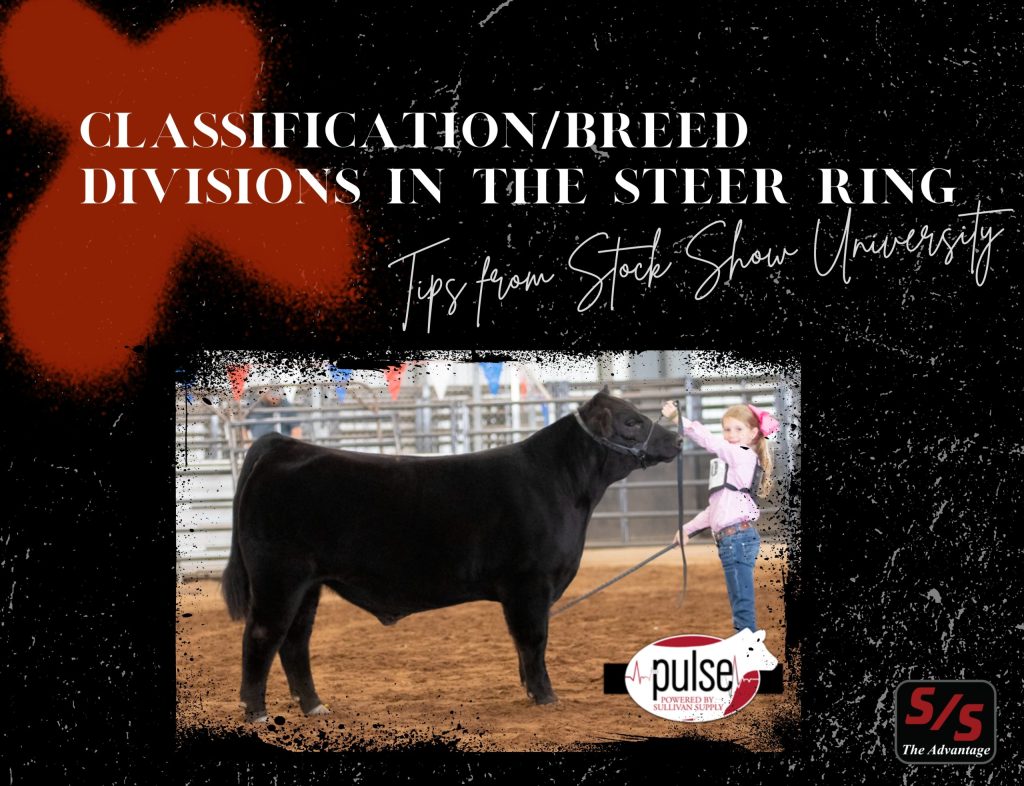Recognizing Classification/Breed Divisions in the Steer Ring | Tips from Stock Show University®
Each steer show that you might attend across the United States could be a little different when you look at how divisions/classes are divided. Some shows require valid breed association papers that identify the animal as a certain breed, while some shows classify animals based on certain phenotypic (visual) traits.
When showing at a classified show, steers should be shown based only on their phenotypic traits, as that is how they will be evaluated for classification. Show classifiers, a group of individuals making sure the steer are placed in the correct division, are asked to exercise their judgment to the best of their ability for the show. In this Stock Show University® tip, we will be presenting an example to you about classifying market steers as breeds in the ring.
Just as a refresher, there are the three types of breeds we classify our animals: British Type, Brahman Type, and Continental Type.
- British Type – This group includes cattle that appear to be purebred Angus, Hereford, Polled Hereford, Red Angus, and Shorthorn.
- Brahman Type – This group is sometimes called American Breeds. Physical evidence of Brahman background is important (ear length and shape, amount of hide, hump/crest).
- Continental Type – Sometimes known as Exotic breeds, this group includes Charolais (half-blood and higher), Limousin, Maine-Anjou (half or higher), and Simmental (purebred).
The example that we are going to give you in this Stock Show University tip is that you have the steer that is in the graphic attached to this story. When entering this steer for the show, you would like to show him in the Angus division.
To make sure that he gets classified for the Angus division, this steer needs to meet the following qualifications:
- Must physically exhibit breed characteristics of a purebred Angus
- Solid Black
- Polled (naturally hornless)
- Needs to have a tight sheath that is round and perpendicular to the ground
- Angus-type ear set, small to moderate ear size high on the head
Keep in mind that discriminatory breed characteristics include:
- Continental breed type structure (being coarse about his joints, not to be confused with big-boned cattle) and head
- Bumps where horns would be on a horned animal
- Birthmarks or white hair in the switch should be reviewed for the skin color (black skin color is acceptable; white or pink skin is a disqualification)
- Non-Angus-type ear set (ear set and excessive ear size as in Continental breeds)
- Large navels and angular sheaths
When looking at the picture, you could say that this steer WOULD pass as an Angus. Below are the absolute disqualifications when looking at Angus steers for the show:
- White skin resulting in white hair above the underline or in the front of the navel (White on the navel is acceptable)
- White skin resulting in white hair on the leg, foot, or tail
- Horns or scurs (undeveloped horn growth)
- Brindle (a streaking of black, brown, or white on the body of the steer, aka tiger stripe)
- Diluter color pattern
- Dehorning scars
- Double muscling
Like stated before, it is always essential to look at the breed qualifications before the show to see where your steer should be placed based only on their phenotypic traits.
For more tips and video tutorials from Stock Show University, visit https://www.sullivansupply.com/stock-show-u/online/.
Sources – https://bigtex.com/wp-content/uploads/2022/09/2022-SFT-Classification-Guidlines.pdf
For more tips and video tutorials from Stock Show University®, visit https://www.sullivansupply.com/stock-show-u/online/


